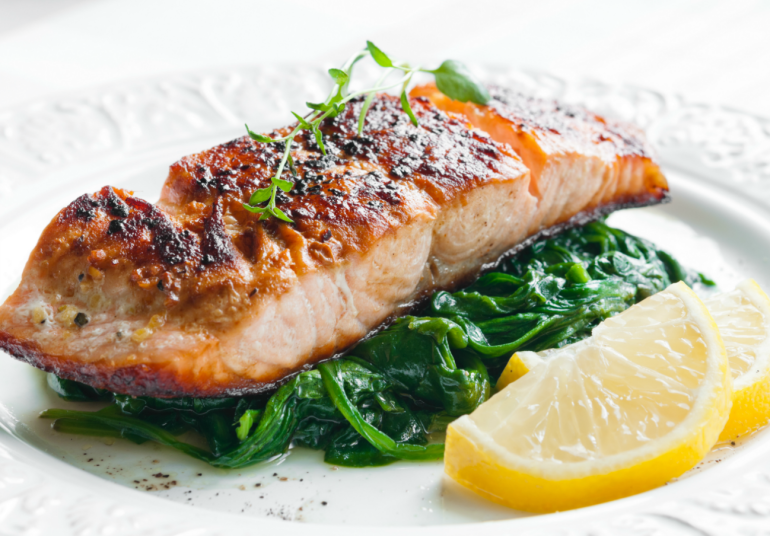9 Ways to Ward off Fibroids and Uterine Cancer

Not planning to have a baby — or long past that stage? It’s still wise to keep your uterus and ovaries in tip-top condition. Why? So they can continue secreting disease-fighting proteins! Here’s how to do it.
Eat fish.
Eating six ounces of any fish, three times weekly, lowers your risk of uterine or ovarian cancer 30 percent, reports the International
Journal of Cancer. Fish’s omega-3 fatty acids are newly proven to intensify your immune system’s ability to kill cancerous
cells before they can grow and spread.
Consume lots of green veggies.
Fibroids — benign uterine tumors — are the top cause of hysterectomies. But you can reduce your risk 41 percent just by eating 1 1/2 cups of green vegetables daily, Italian studies show. Natural plant compounds called isoflavonoids help your liver quickly excrete fibroid-fueling excess estrogen.
Take vitamin D.
The second most common cause of hysterectomies? Severe menstrual cramping and heavy bleeding. Fortunately, a new study suggests taking 2,000 IU of vitamin D-3 (the most
absorbable form) daily can lower your risk of painful periods 24 percent. “Vitamin D helps control and normalize the growth of every cell in your body, including hormone-sensitive uterine and ovarian cells,” says Michael F. Holick, M.D., Ph.D., coauthor of The Vitamin D Solution.
Drink coffee or tea.
Enjoying three cups of coffee, or four cups of tea (black, green, white or oolong), daily can cut your risk of uterine and ovarian
troubles 25 percent, Harvard studies suggest.
Both brews are rich in tissue-nourishing compounds that rev your defenses against gynecologic cancers, fibroids, and other
hormone-triggered woes.
Walk every day.
Already have fibroids, endometriosis or problem periods? Getting 20 minutes of exercise daily will ease your symptoms and cut your risk of gynecologic cancers 18 percent. Exercise increases the flow of blood to and from the pelvis, flushing away pain-triggering prostaglandin hormones. It also reduces the estrogen production that can fuel the growth of fibroids, endometriosis, and cancers.
Take probiotics.
Add this to the list of great reasons to take a probiotic supplement: It not only helps prevent yeast infections, taking a specific one — Lactobacillus gasseri — helps protect against endometriosis, reports the journal Cytotechnology.
Endometriosis occurs when uterine tissue spreads into the pelvis, explains study coauthor Minoru Gotoh, M.D. “This probiotic encourages your immune cells to destroy endometrial tissue that’s spreading to where it doesn’t belong, plus it reduces pain-triggering inflammation.” (Follow package directions for dosage.) Already have endometriosis? The same probiotic can cut related pelvic pain, backache and other symptoms 38 percent in three months.
Get your greens.
Eating a cup a day of spinach or another dark leafy green cuts
fibroid risk 41 percent, studies show. Isoflavonoids in greens help your liver excrete the excess estrogen that fuels fibroids. Already have fibroids? Taking 2,000 IU of vitamin D daily switches off enzymes that rev fibroid growth, shrinking small ones up to 75 percent.
Eat more nuts.
Consuming two cups of nuts weekly cuts your breast cancer
risk 50 percent, and it reduces your risk of benign breast disease— noncancerous lumps and cysts — 40 percent, reports the journal Gynecologic and Obstetric Investigation. Nuts contain minerals and plant fats that encourage breast cells to divide normally.
Have a berry smoothie.
Eating three cups of fresh or frozen berries weekly can cut your
risk of uterine cancer 33 percent, research shows. The fiber in berries blocks the absorption of uterus-damaging carcinogens in the digestive tract — and the pigments in the berries increase the ability of white blood cells to destroy precancerous growths.
Bonus: Regularly eating nutrient-rich berries helps prevent menopausal brain fog, plus slows skin aging, Tufts researchers say.
This article originally appeared in our print magazine, Reverse Aging.
















